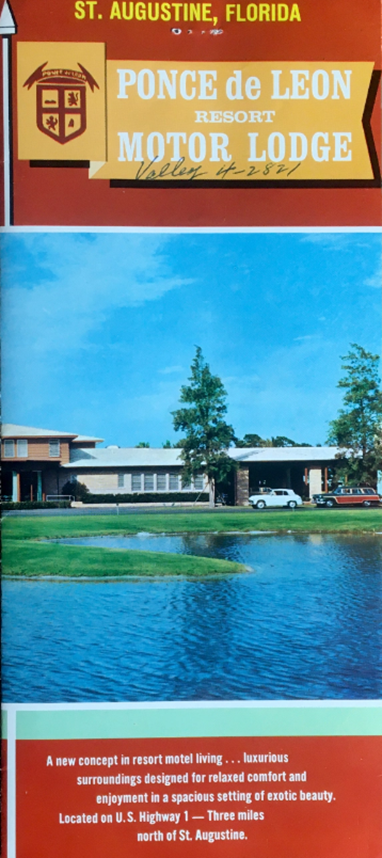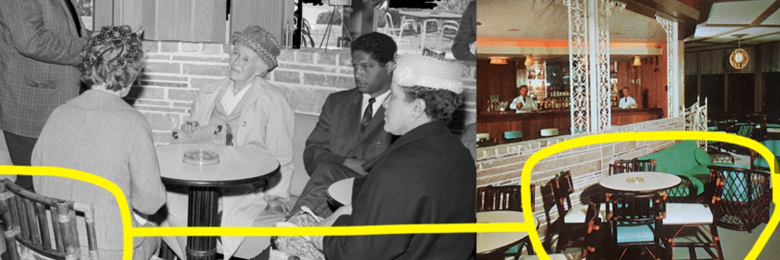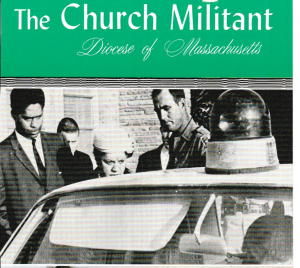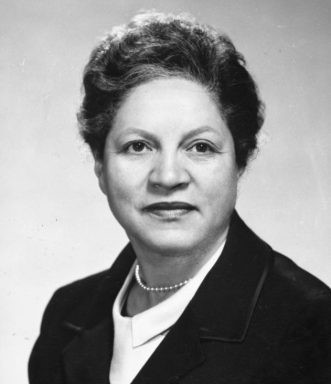Notable Companion Esther Burgess
Notable Companion Esther Burgess
Four prim and proper Episcopalian church ladies dressed in their best duds fly down from Boston to the deeply segregated city of St. Augustine, Florida, a week before Easter Sunday in 1964.
OUR FEATURED PARADISE CHAPTER COMPANION:
Esther Julia Taylor Burgess
Born May 19, 1911, Fredericton, New Brunswick, Canada
Admitted to the SCHC: Spring Conference 1964
Died June 7, 2004, Vineyard Haven, Martha’s Vineyard, MA
When I ask Companions to remember Esther Burgess, the reaction is never lukewarm. Either towering admiration or bone stiffening fear are common reactions. Read on to learn more about this tenacious Companion.
Dateline-St. Augustine FL. March 1964
 Just think. Sun, sand, lobster, romance… Geez.
Just think. Sun, sand, lobster, romance… Geez.
What better way to celebrate the risen Christ and the official start of Spring than in a swanky motel a few miles north of St. Augustine. The 1964 brochure for the Ponce de Leon Motor Lodge shows a sun-washed ultra-modern edifice that would draw in any adventurous traveler to stay the night at the dear price of $22.00 per room.
Unless you’re a Black person, of course. In that case, get out and stay out. But there would be a counterattack afoot. Four prim and proper Episcopalian church ladies dressed in their best duds fly down to the deeply segregated city of St. Augustine, Florida a week before Easter Sunday in 1964.
One lady is a standout. With not a hair out of place and her hat placed just so on her head, Esther Burgess is the wife of the first black bishop within the American Episcopal Church, the Rt. Rev. John Melville Burgess. The spokesperson for the churchwomen was Mary Parkman Peabody, a 1910 Boston Back Bay Debutante, wife of the Bishop of Central New York and mother of the sitting Governor of Massachusetts, Endicott Peabody. Also in attendance are Mrs. Donald J. Campbell and Mrs. Payson Rowe.
The four women are invitees of the Massachusetts Unit of the Southern Baptist Christian Leadership Conference (SBCLC). The local president of the SBCLC in Florida contacted Northern ministers to whip up as many justice-minded people as possible and lead them in staged infiltrations of St. Augustine’s White public spaces. The mission had been in the works for three years. Attempts at desegregation were getting nowhere and St. Augustine was a nursery for the Ku Klux Klan and its budding ne’er do wells and bigots.
The plan: go to restaurants, halls, beaches, and pools in integrated groups and sit down. Before the trip, a gaggle of newspaper reporters gathered in front of Mrs. Peabody and company. A staunch Republican and an ardent believer in law and order, Mrs. Peabody sternly advised the press that her group would not submit to arrest. If asked to leave, they would. Protest the practices of a deeply segregated city? Fine. A dignified lady subjecting herself to arrest and sitting in a clink? Unthinkable. That’s where Mrs. Peabody drew the line. They would have made their point just by participating in the sit-ins. It sounded simple and straight forward, right?
Well, no.
Sorry, Mary Parkman Peabody. Esther Burgess would come to think very differently before the week was out. The night before the demonstrations took place, Mrs. Burgess told her roommate, Hester Campbell, that she could not and would not walk away from those who went to jail. She decided to go to jail with one of the demonstration coordinators, Dr. Robert B. Hayling, at the Motel Ponce de Leon and let the chips fall where they may. Mrs. Campbell was not in favor of going to jail. It would upset her husband.

Inside the Ponce de Leon Motor Lodge Cocktail Lounge from left to right: the picture; Hester Campbell; Mary Parkman Peabody; Dr. Robert B. Hayling, and Esther Burgess. The room still stands today as a historic site in civil rights. (Courtesy of the Black History Project).
The next day, Mrs. Peabody, Mrs. Burgess, Mrs. Campbell, and Dr. Hayling walked into the cocktail lounge and gathered round a table. The motel manager immediately called for the police to clear out the irritants. The charges: being undesirables and breaking the Whites only establishments ordinance that had been in place for as long as the city itself existed.
Burgess and Hayling were whisked away in a separate squad car to keep them away from White protesters. The pair shared the backseat with a huge German Shepherd.
Back at the motel, Mrs. Peabody, Mrs. Rowe, and Mrs. Campbell left peaceably. When asked by reporters how he felt about his wife’s arrest, Bishop Burgess answered that he was “behind his wife 100 percent.”

From left to right: Dr. Robert B. Hayling; Esther Burgess; Unidentified police officer, and the shadow of a German Shepherd in the backseat of a police cruiser. This photo made the front page of the Boston Globe and The Church Militant. (Courtesy of the SCHC Archives)
One of the Black ministers in the thick of the demonstrations asked Mrs. Peabody and Mrs. Campbell why they did not go to jail. Mrs. Campbell said she had to call and ask her husband first. She did. To her surprise he was proud of her and told her she should do what she thought was right.
Mrs. Peabody also said she had to inform her family of her decision. Bishop Malcolm Peabody was quick to encourage his wife to do what she had to do. Mrs. Peabody later admitted that guilt over the arrest of their friend Esther governed the women’s decision to follow her example.
The next day, the other three women were taken away from the same motel and jailed. Newspapers all over the USA splashed photos of the church ladies in their finery sitting in jail and chatting with the other inmates.
The White women stayed in an overcrowded cell next door to the Black women’s cell, which was even more overcrowded. The Black women were so thrilled to see the proper White ladies that they asked the guards to take their mattresses to the older White women to make them more comfortable for the night. Then they softly sang spirituals to help them rest. Hester Campbell cried, and Mary Peabody became even more determined to win the fight against racial segregation. Esther Burgess took the church lady out of her White friends and made them fighters.
This article is only a snapshot of the long life of this great lady. Many Companions would gladly tell you of Esther’s wisdom, humor, edginess, irascibility, and unshakable belief in a God that made her courageous.
She did not know she would be a freedom fighter when she left her hometown at the age of thirty-two to attend college in the United States. Esther left her responsible job with the Canadian government only when she was sure her farming family would be financially stable without her salary. She did not know she would marry a history-making bishop. Nor did she know that she would land in jail and become front page news.
Esther Burgess was a lion in the Civil Rights Movement. And well after her death in 2004 at the age of ninety-three, she will always be a frontpage headliner.

Written by Cynthia D. Pape, SCHC Archivist
Edited by Anne Moore






